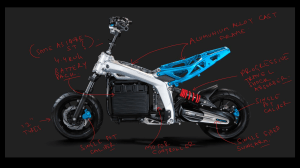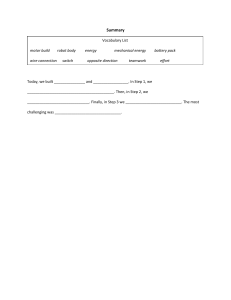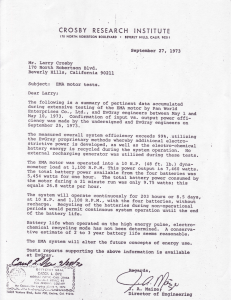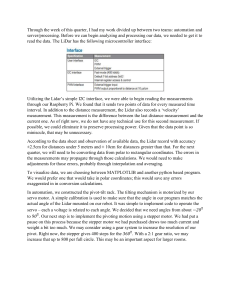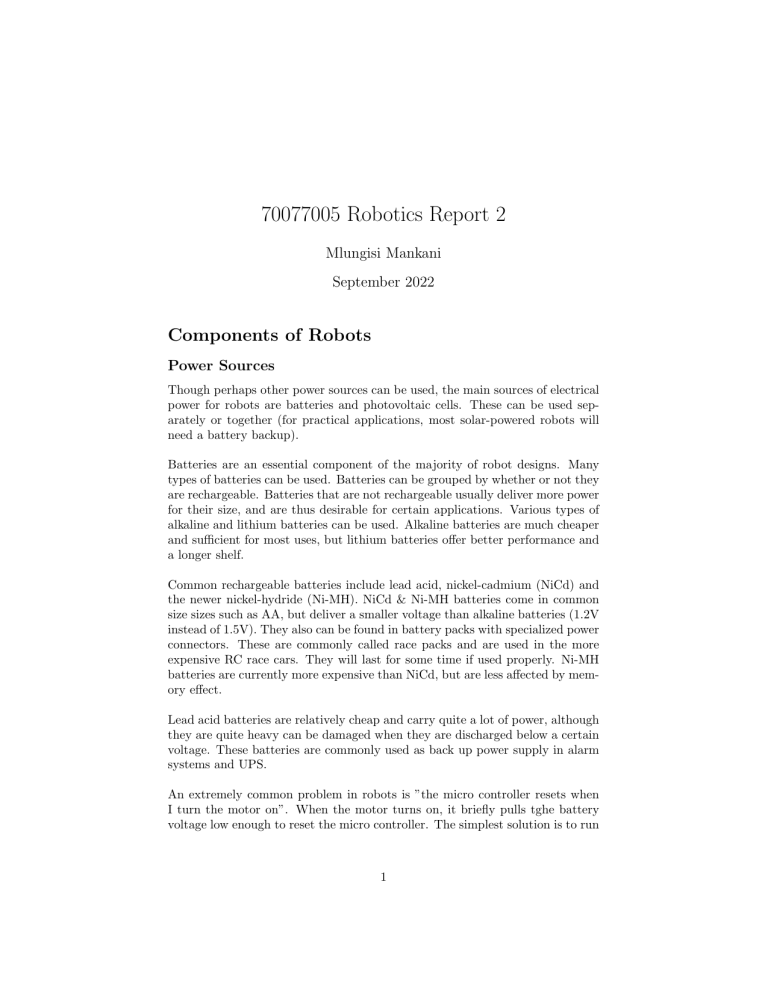
70077005 Robotics Report 2 Mlungisi Mankani September 2022 Components of Robots Power Sources Though perhaps other power sources can be used, the main sources of electrical power for robots are batteries and photovoltaic cells. These can be used separately or together (for practical applications, most solar-powered robots will need a battery backup). Batteries are an essential component of the majority of robot designs. Many types of batteries can be used. Batteries can be grouped by whether or not they are rechargeable. Batteries that are not rechargeable usually deliver more power for their size, and are thus desirable for certain applications. Various types of alkaline and lithium batteries can be used. Alkaline batteries are much cheaper and sufficient for most uses, but lithium batteries offer better performance and a longer shelf. Common rechargeable batteries include lead acid, nickel-cadmium (NiCd) and the newer nickel-hydride (Ni-MH). NiCd & Ni-MH batteries come in common size sizes such as AA, but deliver a smaller voltage than alkaline batteries (1.2V instead of 1.5V). They also can be found in battery packs with specialized power connectors. These are commonly called race packs and are used in the more expensive RC race cars. They will last for some time if used properly. Ni-MH batteries are currently more expensive than NiCd, but are less affected by memory effect. Lead acid batteries are relatively cheap and carry quite a lot of power, although they are quite heavy can be damaged when they are discharged below a certain voltage. These batteries are commonly used as back up power supply in alarm systems and UPS. An extremely common problem in robots is ”the micro controller resets when I turn the motor on”. When the motor turns on, it briefly pulls tghe battery voltage low enough to reset the micro controller. The simplest solution is to run 1 the micro controller on a separate set of batteries. History of the Battery The first evidence of batteries comes from discoveries in Sumerian ruins dating around 250 B.C.E. Archaeological digs in Baghdad, Iraq. But the man most credited for the creation of the battery was named Alessandro Volta, who created his battery in the year 1800 C.E. called the voltaic pile. The voltaic pile was constructed from discs of zinc and copper with pieces of cardboard soaked in salt water between the metal discs. The unit of electric force, the volt, was named to honor Alessandro Volta. How a Battery Works Most batteries have two terminals on the exterior, one end is positive end marked ”+” and the other end is negative marked ”-”. Once a load, any electronic device, a flashlight, a clock, etc., is connected to the battery the circuit being completed, electrons begin flowing from the negative end to positive end, producing a current. Electrons will keep flowing as fast as possible until the chemical reaction on the interior of the battery lasts. Inside the battery there is a chemical reaction going producing the electrons to flow, the speed of production depends on the battery’s internal resistance. Electrons travel from negative to positive end fueling the chemical reaction, if the battery isn’t connected then there is no chemical reaction taking place. That is why a battery (except Lithium batteries) can sit on the shelves for a year and there will still be most of the capacity to use. Once the battery is connected from positive to negative pole, the reaction starts, that explains the reason why people have gotten a burn when a 9-volt battery in their pocket touches a coin or something else metallic to connect the two ends, shorting the battery making electrons flow without any resistance, making it very, very hot. Main Concerns Choosing a Battery - Geometry of the batteries. The shape of the batteries can be an important characteristic according to the form of the robots. - Durability. Primary (disposable) or secondary (rechargeable). - Capacity. the capacity of the battery pack in milliamperes-hour is important. It determines how long the robot will run until a new charge is needed. - Initial cost. This is an important parameter, but a higher initial cost can be offset by a longer expected life. - Environmental factors. Used batteries have to be disposed of and some of them contain toxic materials. 2 Lithium-ion Batteries Advantages: These batteries are much lighter than non-lithium batteries of same size. Made of lithium (obviously) and Carbon. The element Lithium is highly reactive meaning a lot of energy can be stored there. A typical lithium-ion battery can store 150 watt-hours of electricity in 1 kilogram of battery. A NiMH (Nickelmetal hydride) battery pack can store perhaps 100 watt-hours per kilogram, although 60 to 70 watt-hours might be more typical. A lead-acid battery can store only 25 watt-hours per kilogram. Using lead-acid technology, it takes 6 kilogram to store the same amount of energy that a 1 kilogram lithium-ion battery can handle. That is a huge difference! Disadvantages: Begin degrading once they are created, lasting only two or three years tops, used or not. Extremely sensitive to high temperatures, heat degrades battery even faster. If a lithium battery is completely discharged, it is ruined a new one will be needed. Because of size and ability to discharge and recharge hundreds of times it is one of the most expensive rechargeable batteries. And a small chance they could burst into flames (internal short, separator sheet inside battery keeping the positive and negative ends apart gets punctured). Alkaline Batteries The anode, the positive end, is made of zinc powder because the granules have a high surface area, increasing the rate of reaction and higher electron flows. It also helps limit the rate of corrosion. Manganese dioxide is used on the cathode, or the negative side, in powder form as well. And potassium hydroxide is the electrolyte in an alkaline battery. There is a separator inside the battery to separate the electrolyte between the positive and negative electrodes. Actuators Actuators are like the ”muscles” of robots, which convert energy into movement. By far the most popular actuators are electric motors. The vast majority of robots use electric motors, often brushed and brush less DC motors in portable robots in portable robots or AC motors in industrial robots. These motors are often preferred in systems with light loads, and where the predominant form of motion is rotational. AC (alternating current) motors are rarely used in mobile robots because most of the robots are powered with direct current (DC) coming from batteries. AC motors are mainly used in industrial environments where very high torque is required, or where the motors are connected to the mains/ wall outlet. 3 Motor controller A motor controller is an electronic device that helps microcontroller to control the motor. Motor controller acts as an intermediate device between a micro controller, a power supply or batteries, and the motors Although the micro controller (the robot’s brain) decides the speed and direction of the motors, it can not drive them directly because of its very limited power (current and voltage) output. The motor controller, on the other hand, can provide the current at the required voltage but can not decide how the motor should run Thus, the microcontroller and the motor controller have to work together in order to make the motors move appropriately. Usually, the microcontroller can instruct the motor controller on how to power the motors via a standard and simple communication method such as UART or PWM. Also,some motor controller can be manually controlled by an analogue voltage (usually created with a potentiometer). The physical size and weight of a motor controller can significantly, from a device smaller than the tip of your finger used to control a mini sumo robot to a large controller weighing several kg. The size of motor controller is usually related to the maximum current it can provide. Large current means larger size. Since there are several types of motors, there are also several types of motor controllers: Brushed DC Motor A brushed DC motor is one which uses two brushes to conduct current from source to amature. There are several variations on the brush DC motor, but permanent magnet DC motor (PMDC) is used extensively in robotics. Brushed DC motors are widely used in applications ranging from toys to push-button adjustable car seats. Brushed DC (DBC) motors are inexpensive, easy to drive, and are readily available in all sizes and shapes. The brush DC Motor consists of six different components : the axle, armature/rotor, commutator, stator, magnets and brushes. A brush DC Motor consists of two magnets facing the same direction, that surrounding two coils of wire that reside in the middle of the Brush DC motor, around a rotor. The coils are positioned to face the magnets, causing electricity to flow them. This generates a magnetic field, which ultimately pushes the coils away from the magnets they are facing, and causes the rotor to turn. The Brush DC Motor has two terminals; when voltage is applied across the two terminals, a proportional speed is outputted to the shaft of the Brush DC 4 Motor consists of two pieces: the stator which includes the housing, permanent magnets, and brushes, and the rotor, which consist of the output shaft, windings and commutator. The brush DC motor stator is stationary, while the rotor rotates with respect to the Brush DC motor stator. The stator generates a stationary magnetic field that surrounds the rotor. The rotor, also called the armature, is made up of one or more windings. When these windings are energized they produce a magnetic field. The magnetic poles of this rotor will be attracted to the opposite poles generated by the stator , causing the rotor to turn. As the motor turns, the windings are constantly being energized in a different sequence so that the magnetic poles generated by the rotor do not overrun the poles generated in the stator. This switching of the field in the rotor windings is called commutation. Unlike other electric motor types (i.e.,brush less DC, AC induction), BDC motors do not require a controller to switch current in the motor windings. Instead, the commutation of the windings of a BDC motor is done mechanically. A segmented copper sleeve, called a commutator, resides on the axle of a BDC motor. As the motor turns, carbon brushes slide over the commutator, coming in contact with different segments of the commutator. The segments are attached to different rotor windings, therefore, a dynamic magnetic field is generated inside the motor when a voltage is applied across the brushes of the motor. I is important to note that the brushes and commutator are the parts of a BDC motor that are most prone to wear because they are sliding past each other. Advantages: Inexpensive. Lightweight. Reasonably Efficient Sensors LiDAR Sensors for Robotic Systems LiDAR (Light Detection and Ranging) technology assists robots to navigate their surroundings through object perception, identification and collision avoidance. LiDAR sensors provide information in real time about the robot’s surrounding such as walls, doors, people and other objects. LiDAR can assist robots to carry out a wide range of tasks and to operate autonomously. It operates on the time of flight concept, which is a very well tested concept in industry. We know the speed of light through our atmosphere so that means we can send a pulse of light, bounce it off a target, and measure the amount of time it takes to come back. By halving the total time and multiplying by the speed of light, we know the distance to the target. This is the core of how LiDAR works. 5 To capture more data about the surrounding contours, we take pulse of light and bounce it of a rotating mirror. As the laser rotates around, we get all these measurements in a flat plane of measurement. This plane of measurement can be stacked with subsequent planes (like a loaf of sliced bread) to create a threedimensional map, called a point cloud. LiDAR technology has a number of advantages, including a high degree of accuracy, high resolution, and a long-detecting distance. This makes it beneficial to use in numerous applications. First uses of LiDAR The concept of LiDAR was first discovered in 1930 to estimate the distance and density of clouds using searchlights, photographic paper, and a telescopic lens. Building upon that concept, the first prototype for LiDAR technology came shortly after the invention of the laser in 1961 from Hughes Aircraft Company. The original intention was to use it to track satellites and also measure clouds and pollution in the air. The technology gained popularity when the United States’ space program used the technology to map the surface of the moon during the 1971 Apollo 15 mission. Since then, it has been used in numerous applications across a number of industries. NASA continues to use LiDAR for topographic mapping of earth and to study climate change . Geologists use it to create shoreline maps or make digital elevation models. Archaeologists use it to create high resolution maps for surveying. It’s even been used in the entertainment industry to create scans of buildings and cities in 3d for production. You may even have LiDAR in your pocket. The latest iPhones have a tiny LiDAR sensor for augmented reality apps. 6 Sensorized LiDAR This type of LiDAR comes in the form of a compact and lightweight laser scanner. These are considered entry-level technology as they are typically used for simple area monitoring tasks. Sensorized LiDAR products function well even in high ambient light thanks to the High Definition Distance Measurement (HDDM) technology from from SICK. This reduces cost and complexity in LiDAR detection. This type of LiDAR is used in some autonomous vehicle applications, but it is also increasingly used for basic applications on the factory floor. The LiDAR sensor creates an invisible plane of detection and can be oriented to detect the presence of objects that should not be there-perhaps an overfilled bin or a tote with objects hanging out of it. This is especially useful in a packaging and production environment. In bin-picking and pass-through detection applications, sensorized LiDAR can also be used. This allows manufacturers to monitor the production of products and ensure quality control. If an operator reaches into the incorrect bin, the system will signal the operator. Historically this was oft6en done with multiple light curtains , but a single LiDAR device is much simpler to install and wire. Multi-layer LiDAR Some people call it 3D LiDAR and others refer to it as multi-layer or multi channel. This type of LiDAR provides not just a single plane like 2D LiDAR, but three more planes that that provide additional detection. This can be used to detect objects at long distances. Additional planes add an extra layer of detection that 2D LiDAR lacks. For example, if an object isn’t correctly aligned with the plane, another plane may pick it up instead. This allows more flexibility so that if things aren’t perfectly aligned or 100% always in the exact same position, a multi-layer sensor can adapt to it. Solid-State LiDAR Still another type of LiDAR is solid state. Instead of a single plane or multiple planes like the previous two, this type of LiDAR provides a camera view of everything it looks at With this technology, a 3D snapshot is taken of the surrounding area that goes beyond just an image. It also provides the depth or distance associated with each ”pixel” of that image. 7 This type of LiDAR can be used in many AMR applications, but also works well in other applications. For example, in bin picking applications, the LiDAR can provide a 3D image of whatever is in the bin, allowing the robot to know when and what it should pick up.One final application is in package dimensioning for pallet loading. In pallet loading it’s common to use a robot’s suction gripper to collect several cartons and stack them on a pallet. By adding LiDAR to the end effector, the robot can now determine the position and dimensions of the carton so that it can adapt its grip dynamically to improve efficiency and reduce errors. The camera is quick to install, ready for operation immediately, and provides reliable high-quality 3D data in just one shot. Controllers Advanced RISC Machine (ARM) Advanced RISC Machine (ARM) is a processor architecture based on a 64/32 bit reduced instruction set (RISC) computer. ARM features include: • Load/store-based architecture. • Single-cycle instruction execution. • Link register. • Easy decoding and pipelining. • Power-indexed addressing modes. • Fixed 32-bit instruction set History of Arm Processors ARM machines have a history of living up to the expectations of their developers, right from the very first ARM machine ever developed. It all began in the 1980s when Acorn Computers Ltd., spurred by the success of their platform BBC Micro wished to move on from simple CMOS processor to something more powerful, something that could stand strong against IBM machines launched in 1981. The solutions available in the like the Motorola 68000 were not powerful enough to handle graphics and GUIs leaving only one option with the company, make their own processor. Inspired by the making of 32 bit processors by some undergraduates at Berkeley and a one man design centre Western Design Centre, Phoenix, Steve Furber and Sophie Wilson of Acorn Ltd. set out to make their own processors. Sophie developed the instruction set and simulated it on the BBC Basic which convinced many in the company that it was not just anything half hearted shotaimed in darkness. With the support and permission of the then CEO Hermann Hauser, 8 the ARM project formally took off inn the 1983 with VLSI Technology as their silicon partner, to produce an ARM processor with latencies as low as that of the 6502. The first ARM core dubbed as ARM1 was delivered by VLSI Technology in 1985. This processor used in conjunction with the BBC Micro helped in the development of the next generation called ARM2. 1987 saw the release of ARM Archimedes. Applications in robotics like the ARM Rubik’s Speedcuber are gaining popularity. With the rising popularity of smartphones as their market penetration increases, the ARM cores are gaining more popularity.Over 1.15 billion ARM chips have been placed in tablets and smart phones. Dual cores like the LG Optimus 2X have started using the latest in the line Cortex cores to deliver more performance in reduced space requirements. (Words: 3014) 9
